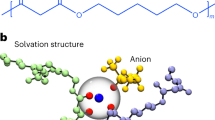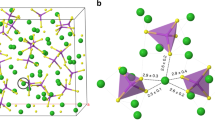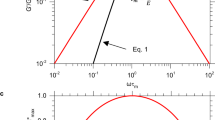Abstract
The relation between mechanical and electrical relaxation in polymer/lithium-salt complexes is a fascinating and still unresolved problem in condensed-matter physics1, yet has an important bearing on the viability of such materials for use as electrolytes in lithium batteries. At room temperature, these materials are biphasic: they consist of both fluid amorphous regions and salt-enriched crystalline regions. Ionic conduction is known to occur predominantly in the amorphous fluid regions. Although the conduction mechanisms are not yet fully understood2, it is widely accepted that lithium ions, coordinated with groups of ether oxygen atoms on single or perhaps double polymer chains, move through re-coordination with other oxygen-bearing groups3,4. The formation and disruption of these coordination bonds must be accompanied by strong relaxation of the local chain structure. Here we probe the relaxation on a nanosecond timescale using quasielastic neutron scattering, and we show that at least two processes are involved: a slow process with a translational character and one or two fast processes with a rotational character. Whereas the former reflects the slowing-down of the translational relaxation commonly observed in polyethylene oxide and other polymer melts, the latter appears to be unique to the polymer electrolytes and has not (to our knowledge) been observed before. A clear picture emerges of the lithium cations forming crosslinks between chain segments and thereby profoundly altering the dynamics of the polymer network.
This is a preview of subscription content, access via your institution
Access options
Subscribe to this journal
Receive 51 print issues and online access
$199.00 per year
only $3.90 per issue
Buy this article
- Purchase on Springer Link
- Instant access to full article PDF
Prices may be subject to local taxes which are calculated during checkout




Similar content being viewed by others
References
Gray, F. M. Polymer Electrolytes (Materials Monographs, Royal Society of Chemistry, Cambridge, 1997).
Berthier, C. et al. Microscopic investigation of ionic conductivity in alkali metal salts-poly(ethylene oxide) adducts. Solid State Ionics 11, 91–95 (1983).
Bruce, P. G. & Vincent, C. A. Polymer electrolytes. J. Chem. Soc. Faraday Trans. 89, 3187–3203 (1993).
Ratner, M. A. in Polymer Electrolytes Review —1 (eds McCallum, J. R. & Vincent, C. A.) 173–236 (Elsevier, London, 1987).
Donoso, J. P. et al. Nuclear magnetic relaxation study of poly(ethylene oxide)-lithium salt based electrolytes. J. Chem. Phys. 98, 10026–10036 (1993).
Müller-Plathe, F. & van Gunsteren, W. F. Computer simulation of a polymer electrolyte: lithium iodide in amorphous poly(ethylene oxide). J. Chem. Phys. 103, 4745–4756 (1995).
Torrell, L. M., Jacobsson, P., Sidebottom, D. & Petersen, G. The importance of ion-polymer crosslinks in polymer electrolytes. Solid State Ionics, 53–56, 1037–1043 (1992).
Bée, M. Quasielastic Neutron Scattering (Adam Hilger, Bristol, UK, 1988).
Carlsson, P. et al. Neutron-scattering studies of a polymer electrolyte, PPO-LiClO4. Solid State Ionics, 113–115, 139–147 (1998).
Gabrys, B., Westerhuijs, P., Fishburn, J. & Barton, S. in Quasielastic Neutron Scattering: Future Prospects on High-Resolution Inelastic Neutron Scattering (eds Colmenero, J., Alegria, A. & Bermejo, F. J.) 221–226 (World Scientific, Singapore, 1994).
Vallee, A., Besner, S. & Prud’homme, J. Comparative study of poly(ethylene oxide) electrolytes made with LiN(CF3SO2)2, LiCF3SO3 and LiClO4: thermal properties and conductivity behaviour. Electrochim. Acta 37, 1579–1583 (1992).
Armand, M., Gorecki, W. & Andreani, R. Perfluorosulfonimide salts as solute for polymer electrolytes Proc. 2nd Int. Symp. on Polymer Electrolytes (ed. Scrosati, B.) 91–97 (Elsevier, New York, 1990).
Mao, G., Saboungi, M.-L., Price, D. L. & Armand, M. B. Structure of liquid PEO–LiTFSI electrolyte. Phys. Rev. Lett. (in the press).
Arbe, A., Colmenero, J., Monkenbusch, M. & Richter, D. Dynamics of glass-forming polymers: “homogeneous” versus “heterogeneous” scenario. Phys. Rev. Lett. 81, 590–593 (1998).
Strobl, G. The Physics of Polymers (Springer, New York, 1996).
Rey, I., Johansson, P., Lindgren, J., Lassegues, J. C., Grondin, J. & Servant, L. Spectroscopic and theoretical study of (CF3SO2)2N- (TFSI-) and (CF3SO2)2NH (HTFSI). J. Phys. Chem. A 102, 3249–3258 (1998).
Acknowledgements
This work was supported by The Divisions of Chemical Sciences and Materials Sciences, Office of Basic Energy Sciences, US Department of Energy. We thank M. B. Armand for pointing us to the PEO–LiTFSI electrolyte and for discussions, U. Buchenau for critical reading of the manuscript, the ISIS staff for experimental support, and D. S. Sivia for providing fitting routines.
Author information
Authors and Affiliations
Corresponding author
Rights and permissions
About this article
Cite this article
Mao, G., Perea, R., Howells, W. et al. Relaxation in polymer electrolytes on the nanosecond timescale. Nature 405, 163–165 (2000). https://doi.org/10.1038/35012032
Received:
Accepted:
Issue Date:
DOI: https://doi.org/10.1038/35012032
This article is cited by
-
The significance of fillers in composite polymer electrolytes for optimizing lithium battery
Ionics (2024)
-
Nanofiber Materials for Lithium-Ion Batteries
Advanced Fiber Materials (2023)
-
Impact of exfoliation/intercalation of nano-clay on structure, morphology and electrical properties of poly (ethylene oxide) based solid nanocomposite electrolytes
Journal of Polymer Research (2021)
-
Poly(Ethylene Oxide)-based Electrolyte for Solid-State-Lithium-Batteries with High Voltage Positive Electrodes: Evaluating the Role of Electrolyte Oxidation in Rapid Cell Failure
Scientific Reports (2020)
-
Graph dynamical networks for unsupervised learning of atomic scale dynamics in materials
Nature Communications (2019)
Comments
By submitting a comment you agree to abide by our Terms and Community Guidelines. If you find something abusive or that does not comply with our terms or guidelines please flag it as inappropriate.



